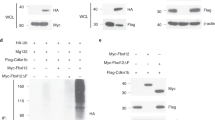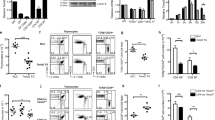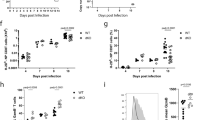Key Points
-
E-proteins are helix–loop–helix (HLH) transcription factors that are important regulators of lymphocyte development. The mammalian E-proteins are encoded by the E2A, HEB and E2-2 genes.
-
Id proteins act as dominant-negative inhibitors of E-protein function by forming dimers with E-proteins that are unable to bind DNA. There are four mammalian Id proteins, which have been designated Id1–4.
-
E2A proteins are absolutely essential for the initial steps of B-cell differentiation, before irreversible commitment to the B lineage. E2A proteins are also important for the initial stages of T-cell development in the thymus, although some T-cell maturation does occur in an E2A-deficient background.
-
E2A proteins have been shown to regulate the expression of several genes that are important in the initial stages of B- and T-cell development. These include early B-cell factor (EBF) and Pax5 in pro-B cells, the pre-Tα gene in DN thymocytes, and the RAG genes in both lymphocyte lineages.
-
HEB null mice show T-cell developmental defects that are distinct from that of E2A-deficient mice, involving disruption of the DN–DP transition. So, E2A and HEB proteins have at least some unique functions in T-cell differentiation.
-
E2A proteins act as attenuators of thymocyte positive selection. Signals initiated by the crosslinking of the T-cell receptor (TCR) complex and transmitted through the RAS–ERK–MAP kinase pathway act to inhibit E-protein activity, at least in part through an increase in the levels of Id3.
-
Id3 is essential for normal thymocyte positive selection. The effects of an absence of Id3 on positive selection can be suppressed by a deficiency of E2A, showing that E2A and Id3 interact both biochemically and genetically in T-cell development.
-
E2A proteins are essential for maintaining the block in development caused by mutations in genes required for TCRβ rearrangement and expression, such as RAG and scid. Signalling through the pre-TCR complex in double-negative thymocytes acts to inhibit E-protein activity through mechanisms that seem similar to those observed for αβTCR signalling at the double-positive stage.
-
E2A protein activity also seems to affect later stages of B-cell development. The apoptotic effects of transforming growth factor-β on B-cell progenitor cultures are dependent on Id3 and, in activated B cells, E2A is probably necessary for the promotion of isotype switching.
-
Enforced Id expression inhibits the development of lymphoid dendritic cells (DCs). These data imply that other factors act downstream of E-proteins to determine T versus DC fate.
Abstract
Helix–loop–helix proteins are essential factors for lymphocyte development and function. In particular, E-proteins are crucial for commitment of lymphoid progenitors to the B- and T-cell lineages. E-proteins are negatively regulated by the Id class of helix–loop–helix proteins. The Id proteins function as dominant-negative inhibitors of E-proteins by inhibiting their ability to bind DNA. Here, we review the role of E-proteins and their Id protein antagonists in lymphocyte proliferation and developmental progression. In addition, we discuss how E-protein activity and Id gene expression are regulated by T-cell receptor (TCR) and pre-TCR-mediated signalling.
This is a preview of subscription content, access via your institution
Access options
Subscribe to this journal
Receive 12 print issues and online access
$209.00 per year
only $17.42 per issue
Buy this article
- Purchase on Springer Link
- Instant access to full article PDF
Prices may be subject to local taxes which are calculated during checkout




Similar content being viewed by others
References
Benschop, R. J. & Cambier, J. C. B cell development: signal transduction by antigen receptors and their surrogates. Curr. Opin. Immunol. 11, 143–151 (1999).
Zuniga-Pflucker, J. C. & Lenardo, M. J. Regulation of thymocyte development from immature progenitors. Curr. Opin. Immunol. 8, 215–224 (1996).
Massari, M. E. & Murre, C. Helix–loop–helix proteins: regulators of transcription in eucaryotic organisms. Mol. Cell. Biol. 20, 429–440 (2000).
Murre, C., McCaw, P. S. & Baltimore, D. A new DNA binding and dimerization motif in immunoglobulin enhancer binding, daughterless, MyoD, and myc proteins. Cell 56, 777–783 (1989).
Hu, J.-S., Olson, E. N. & Kingston, R. E. HEB, a helix– loop–helix protein related to E2A and ITF2 that can modulate the DNA-binding ability of myogenic regulatory factors. Mol. Cell. Biol. 12, 1031–1042 (1992).
Henthorn, P., Mccarrick-Walmsley, R. & Kadesch, T. Sequence of the cDNA encoding ITF-1, a positive-acting transcription factor. Nucleic Acids Res. 18, 677 (1990).
Corneliussen, B., Thornell, A., Hallberg, B. & Grundstrom, T. Helix–loop–helix transcriptional activators bind to a sequence in glucocorticoid response elements of retrovirus enhancers. J. Virol. 65, 6084–6093 (1991).
Zhuang, Y., Soriano, P. & Weintraub, H. The helix–loop–helix gene E2A is required for B cell formation. Cell 79, 875–884 (1994).
Bain, G. et al. E2A proteins are required for proper B cell development and initiation of immunoglobulin gene rearrangements. Cell 79, 885–892 (1994).
Urbanek, P., Wang, Z., Fetka, I., Wagner, E. F. & Busslinger, M. Complete block of early B cell differentiation and altered patterning of the posterior midbrain in mice lacking Pax5/BSAP. Cell 79, 901–912 (1994).
Nutt, S. L., Urbanek, P., Rolink, A. & Busslinger, M. Essential functions of Pax5 (BSAP) in pro-B cell development: difference between fetal and adult B lymphopoiesis and reduced V-to-DJ recombination at the IgH locus. Genes Dev. 11, 476–491 (1997).
Nutt, S. L., Heavey, B., Rolink, A. G. & Busslinger, M. Commitment to the B-lymphoid lineage depends on the transcription factor Pax5. Nature 401, 556–562 (1999).
Kee, B. L. & Murre, C. Induction of early B cell factor (EBF) and multiple B lineage genes by the basic helix–loop–helix transcription factor E12. J. Exp. Med. 188, 699–713 (1998).
Lin, H. & Grosschedl, R. Failure of B-cell differentiation in mice lacking the transcription factor EBF. Nature 376, 263–267 (1995).
Bain, G. et al. E2A deficiency leads to abnormalities in αβ T-cell development and to rapid development of T-cell lymphomas. Mol. Cell. Biol. 17, 4782–4791 (1997).
Godfrey, D. I. & Zlotnik, A. Control points in early T-cell development. Immunol. Today 14, 547–553 (1993).
Ardavin, C., Wu, L., Li, C. L. & Shortman, K. Thymic dendritic cells and T cells develop simultaneously in the thymus from a common precursor population. Nature 362, 761–763 (1993).
Godfrey, D. I., Kennedy, J., Mombaerts, P., Tonegawa, S. & Zlotnik, A. Onset of TCRβ gene rearrangement and role of TCRβ expression during CD3−CD4−CD8− thymocyte differentiation. J. Immunol. 152, 4783–4792 (1994).
Petrie, H. T., Livak, F., Burtrum, D. & Mazel, S. T cell receptor gene recombination patterns and mechanisms: cell death, rescue, and T cell production. J. Exp. Med. 182, 121–127 (1995).
Wu, L., Li, C.-L. & Shortman, K. Thymic dendritic cell precursors: relationship to the T lymphocyte lineage and phenotype of the dendritic cell progeny. J. Exp. Med. 184, 903–911 (1996).
Engel, I., Johns, C., Bain, G., Rivera, R. R. & Murre, C. Early thymocyte development is regulated by modulation of E2A protein activity. J. Exp. Med. 194, 733–745 (2001).Describes the abrogation of the developmental block in Rag null or scid mutant thymocytes by a deficiency in E2A proteins, and shows that E-box binding activity is decreased and Id3 RNA transcripts accumulate in the thymocytes of Rag null mice injected with antibodies against CD3. It also presents flow cytometric analysis of E47 protein levels in thymocyte subsets.
Herblot, S., Steff, A.-M., Hugo, P., Aplan, P. D. & Hoang, T. SCL and LMO1 alter thymocyte differentiation: inhibition of E2A-HEB function and pre-TCRα chain gene expression. Nature Immunol. 1, 138–144 (2000).
Bain, G., Romanow, W. J., Albers, K., Havran, W. L. & Murre, C. Positive and negative regulation of V(D)J recombination by the E2A proteins. J. Exp. Med. 189, 289–300 (1999).
Heemskerk, M. H. M. et al. Inhibition of T cell and promotion of natural killer cell development by the dominant negative helix–loop–helix factor Id3. J. Exp. Med. 186, 1597–1602 (1997).
Yokota, Y. et al. Development of peripheral lymphoid organs and natural killer cells depends on the helix–loop–helix inhibitor Id2. Nature 397, 702–706 (1999).Reference 24 shows that Id2 is essential for the development of NK cells, whereas reference 25 shows that enforced expression of Id3 can promote NK and inhibit T-cell development. Taken together, the data strongly imply that the balance of E- and Id-protein activity is an important determinant of the T-versus NK-cell-fate decision.
Shen, C. P. & Kadesch, T. B-cell-specific DNA binding by an E47 homodimer. Mol. Cell. Biol. 15, 4518–4524 (1995).
Sawada, S. & Littman, D. R. A heterodimer of HEB and an E12-related protein interacts with the CD4 enhancer and regulates its activity in T-cell lines. Mol. Cell. Biol. 13, 5620–5628 (1993).
Zhuang, Y., Barndt, R. J., Pan, L., Kelley, R. & Dai, M. Functional replacement of the mouse E2A gene with a human HEB cDNA. Mol. Cell. Biol. 18, 3340–3349 (1998).
Zhuang, Y., Cheng, P. & Weintraub, H. B lymphocyte development is regulated by the combined dosage of three helix–loop–helix genes, E2A, E2-2 and HEB. Mol. Cell. Biol. 16, 2898–2905 (1996).
Barndt, R., Dai, M. & Zhuang, Y. A novel role for HEB downstream or parallel to the pre-TCR signaling pathway during thymopoiesis. J. Immunol. 163, 3331–3343 (1999).
Blom, B. et al. Disruption of αβ but not γδ T cell development by overexpression of the helix–loop–helix protein Id3 in committed T cell progenitors. EMBO J. 18, 2793–2802 (1999).
Takeuchi, A. et al. E2A and HEB activate the pre-TCRα promoter during immature T cell development. J. Immunol. 167, 2157–2163 (2001).
Ghosh, J. K., Romanow, W. J. & Murre, C. Induction of a diverse T cell receptor γ/δ repertoire by the helix–loop–helix proteins E2A and HEB in nonlymphoid cells. J. Exp. Med. 193, 769–776 (2001).
Romanow, W. J. et al. E2A and EBF act in synergy with the V(D)J recombinase to generate a diverse immunoglobulin repertoire in nonlymphoid cells. Mol. Cell 5, 343–353 (2000).
Barndt, R. J., Dai, M. & Zhuang, Y. Functions of E2A/HEB heterodimers in T-cell development revealed by a dominant negative mutation of HEB. Mol. Cell. Biol. 20, 6677–6685 (2000).
Saint-Ruf, C. et al. Analysis and expression of a cloned pre-T cell receptor gene. Science 266, 1208–1212 (1994).
Reizis, B. & Leder, P. The upstream enhancer is necessary and sufficient for the expression of the pre-T cell receptor α gene in immature T lymphocytes. J. Exp. Med. 194, 979–990 (2001).
Reizis, B. & Leder, P. Expression of the mouse pre-T cell receptor α gene is controlled by an upstream region containing a transcriptional enhancer. J. Exp. Med. 189, 1669–1678 (1999).
Kisielow, P., Bluthmann, H., Staerz, U. D., Steinmetz, M. & von Boehmer, H. Tolerance in T-cell-receptor transgenic mice involves deletion of nonmature CD4+8+ thymocytes. Nature 333, 742–746 (1988).
Kaye, J. et al. Selective development of CD4+ T cells in transgenic mice expressing a class II MHC-restricted antigen receptor. Nature 341, 746–749 (1989).
Bain, G., Quong, M. W., Soloff, R. S., Hedrick, S. M. & Murre, C. Thymocyte maturation is regulated by the activity of the helix–loop–helix protein, E47. J. Exp. Med. 190, 1605–1616 (1999).This paper shows that E2A-deficient mice exhibit increased thymocyte positive selection when bred into the HY or transgenic TCR backgrounds.
Rivera, R. R., Johns, C. P., Quan, J., Johnson, R. S. & Murre, C. Thymocyte selection is regulated by the helix–loop–helix inhibitor protein, Id3. Immunity 12, 17–26 (2000).Shows that Id3 null mice exhibit a severe reduction in the efficiency of thymocyte positive selection, and that this defect seems to be suppressed in an E2A-deficient background.
Bain, G. et al. Regulation of the helix–loop–helix proteins, E2A and Id3, by the Ras-ERK MAPK cascade. Nature Immunol. 2, 165–171 (2001).The authors show that crosslinking of the TCR complex on DP thymocytes results in a reduction in E-box binding activity, which is consistent with the reported effects of E2A deficiency on positive selection. The authors dissect the pathway leading to E-protein inhibition, presenting evidence that activation of the Ras–Erk–MAP kinase pathway by TCR crosslinking leads to expression of the Egr1 transcription factor, which in turn acts to upregulate Id3 RNA.
Alessi, D. R., Cuenda, A., Cohen, P., Dudley, D. T. & Saltiel, A. R. PD 098059 is a specific inhibitor of the activation of mitogen- activated protein kinase kinase in vitro and in vivo. J. Biol. Chem. 270, 27489–27494 (1995).
Dudley, D. T., Pang, L., Decker, S. J., Bridges, A. J. & Saltiel, A. R. A synthetic inhibitor of the mitogen-activated protein kinase cascade. Proc. Natl Acad. Sci. USA 92, 7686–7689 (1995).
Pages, G. et al. Defective thymocyte maturation in p44 MAP kinase (Erk 1) knockout mice. Science 286, 1374–1377 (1999).
Alberola-Ila, J., Forbush, K. A., Seger, R., Krebs, E. G. & Perlmutter, R. M. Selective requirement for MAP kinase activation in thymocyte differentiation. Nature 373, 620–623 (1995).
Levelt, C. N., Mombaerts, P., Iglesias, A., Tonegawa, S. & Eichmann, K. Restoration of early thymocyte differentiation in T-cell receptor β-chain-deficient mutant mice by transmembrane signaling through CD3ɛ. Proc. Natl Acad. Sci. USA 90, 11401–11405 (1993).
Shinkai, Y. & Alt, F. W. CD3ɛ-mediated signals rescue the development of CD4+CD8+ thymocytes in Rag-2−/− mice in the absence of TCRβ chain expression. Int. Immunol. 6, 995–1001 (1994).
Quong, M. W., Harris, D. P., Swain, S. L. & Murre, C. E2A activity is induced during B-cell activation to promote immunoglobulin class switch recombination. EMBO J. 18, 6307–6318 (1999).
Pan, L., Sato, S., Frederick, J. P., Sun, X. H. & Zhuang, Y. Impaired immune responses and B-cell proliferation in mice lacking the Id3 gene. Mol. Cell. Biol. 19, 5969–5980 (1999).
Kee, B. L., Rivera, R. R. & Murre, C. Id3 inhibits B lymphocyte progenitor growth and survival in response to TGF-β. Nature Immunol. 2, 242–247 (2001).
Massague, J. TGF-β signal transduction. Annu. Rev. Biochem. 67, 753–791 (1998).
Park, S. T., Nolan, G. P. & Sun, X.-H. Growth inhibition and apoptosis due to restoration of E2A activity in T cell acute lymphoblastic leukemia cells. J. Exp. Med. 189, 501–508 (1999).
Engel, I. & Murre, C. Ectopic expression of E47 or E12 promotes the death of E2A-deficient lymphomas. Proc. Natl Acad. Sci. USA 96, 996–1001 (1999).
Kim, D., Peng, X. C. & Sun, X. H. Massive apoptosis of thymocytes in T-cell-deficient Id1 transgenic mice. Mol. Cell. Biol. 19, 8240–8253 (1999).
Sloan, S. R., Shen, C. P., McCarrick-Walmsley, R. & Kadesch, T. Phosphorylation of E47 as a potential determinant of B-cell-specific activity. Mol. Cell. Biol. 16, 6900–6908 (1996).
Neufeld, B. et al. Serine/threonine kinases 3pK and MAPK-activated protein kinase 2 interact with the basic helix–loop–helix transcription factor E47 and repress its transcriptional activity. J. Biol. Chem. 275, 20239–20242 (2000).
Chu, C. & Kohtz, D. S. Identification of the E2A gene products as regulatory targets of the G1 cyclin-dependent kinases. J. Biol. Chem. 276, 8524–8534 (2001).
von Boehmer, H. Coming to grips with Notch. J. Exp. Med. 194, F43–F46 (2001).
Radtke, F. et al. Deficient T cell fate specification in mice with an induced inactivation of Notch1. Immunity 10, 547–558 (1999).
Pui, J. C. et al. Notch1 expression in early lymphopoiesis influences B versus T lineage determination. Immunity 11, 299–308 (1999).
Ordentlich, P. et al. Notch inhibition of E47 supports the existence of a novel signaling pathway. Mol. Cell. Biol. 18, 2230–2239 (1998).
Robey, E. et al. An activated form of Notch influences the choice between CD4 and CD8 T cell lineages. Cell 87, 483–492 (1996).
Allman, D. et al. Separation of Notch1 promoted lineage commitment and expansion/transformation in developing T cells. J. Exp. Med. 194, 99–106 (2001).
Res, P. C., Couwenberg, F., Vyth-Dreese, F. A. & Spits, H. Expression of pTα mRNA in a committed dendritic cell precursor in the human thymus. Blood 94, 2647–2657 (1999).
Spits, H., Couwenberg, F., Bakker, A. Q., Weijer, K. & Uittenbogaart, C. H. Id2 and Id3 inhibit development of CD34+ stem cells into predendritic cell (pre-DC)2 but not into pre-DC1. Evidence for a lymphoid origin of pre-DC2. J. Exp. Med. 192, 1775–1784 (2000).This paper shows that enforced Id expression can block the development of lymphoid DCs. The data imply that there are other factors that act downstream of E-proteins to influence the T versus DC cell-fate decision.
Author information
Authors and Affiliations
Corresponding author
Glossary
- ANERGIZED
-
A state of non-responsiveness to antigen.
- SCID MUTANT
-
A naturally occurring mouse mutant with severe combined immune deficiency, due to an inability to rearrange antigen-receptor chain genes.
- SMAD FAMILY
-
Transcription factors that are activated by TGF-β signalling.
- NOTCH SIGNALLING
-
A signalling system comprising highly conserved transmembrane receptors that regulate cell-fate choice in the development of many cell lineages, including lymphocytes.
Rights and permissions
About this article
Cite this article
Engel, I., Murre, C. The function of E- and id proteins in lymphocyte development. Nat Rev Immunol 1, 193–199 (2001). https://doi.org/10.1038/35105060
Issue Date:
DOI: https://doi.org/10.1038/35105060
This article is cited by
-
Loss of Zfp335 triggers cGAS/STING-dependent apoptosis of post-β selection thymocytes
Nature Communications (2022)
-
Paradoxical role of Id proteins in regulating tumorigenic potential of lymphoid cells
Frontiers of Medicine (2018)
-
The Id-protein family in developmental and cancer-associated pathways
Cell Communication and Signaling (2017)
-
The ID proteins: master regulators of cancer stem cells and tumour aggressiveness
Nature Reviews Cancer (2014)
-
Dysregulated Gene Expression During Hematopoietic Differentiation From Human Embryonic Stem Cells
Molecular Therapy (2011)



